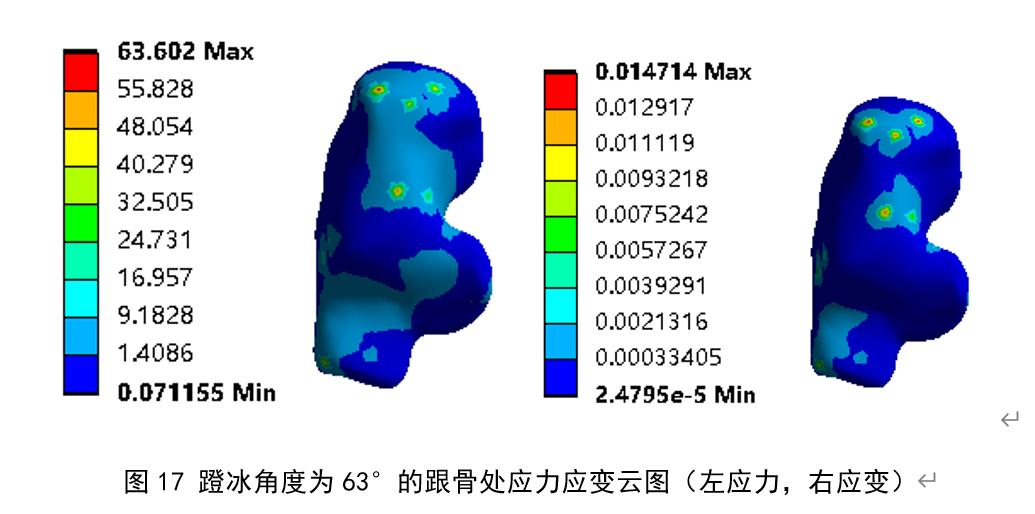
本研究使用ANSYS WORKBENCH 20 R2软件模拟蹬冰角度为63°时足-速滑鞋有限元模型足踝部应力与应变。首先,设置约束载荷,约束胫腓骨上平面前后、左右、上下的位移;其次,加载跟腱力 ,跟腱力为足部承受载荷的75%。蹬冰过程中垂直方向地面反作用力为体重的 1.5-2.5倍,所以本次研究的地面反作用力设置为体重的两倍,为1280N,跟腱力即为960N;再次,调整足鞋和冰面的角度,本研究蹬冰角度设置为63度;最后,加载位移载荷,地面反作用力通过冰面垂直向上运动,经过多次试验,找到冰面向上运动达到地面反作用力(640N)的具体距离,同时约束冰面的水平和前后方向。冰刀和冰面之间的摩擦系数为0.003。模拟出足踝部跟骨应力为63.602MPa,距骨应力为77.197MPa,踝关节软骨应力为0.649MPa,足底筋膜应力为0.866MPa,跟骨应变为0.015,距骨应变为0.018,踝关节软骨应变为0.650,足底筋膜应变为0.002。
In this study, ANSYS WORKBENCH 20 R2 software was used to simulate the stress and strain of the ankle of the foot-speed skate finite element model when the pedal angle was 63 °. First, set the constraint load to constrain the displacement of the upper plane of the tibia and fibula from front to back, left to right, up and down; Secondly, load the Achilles tendon force, which is 75% of the load on the foot. The ground reaction force in the vertical direction is 1.5-2.5 times of the body weight during the ice pedaling process, so the ground reaction force in this study is set to be twice of the body weight, 1280N, and the Achilles tendon force is 960N; Thirdly, adjust the angle between the foot shoes and the ice surface, and set the pedal angle to 63 degrees in this study; Finally, the displacement load is loaded, and the ground reaction force moves vertically upward through the ice surface. After many tests, the specific distance between the upward movement of the ice surface and the ground reaction force (640N) is found, and the horizontal and front and rear directions of the ice surface are constrained. The friction coefficient between the ice skate and the ice surface is 0.003. The simulated calcaneal stress of the ankle is 63.602MPa, the talus stress is 77.197MPa, the ankle cartilage stress is 0.649MPa, the plantar fascia stress is 0.866MPa, the calcaneal strain is 0.015, the talus strain is 0.018, the ankle cartilage strain is 0.650, and the plantar fascia strain is 0.002.